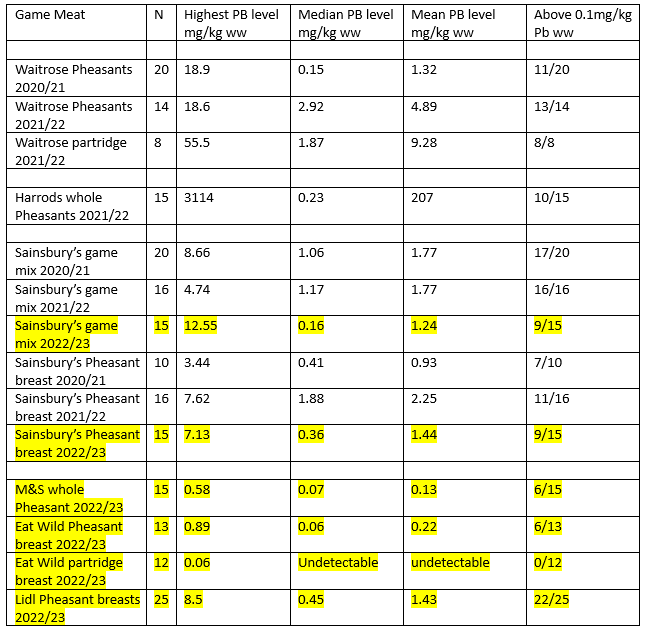Are lead levels falling in game meat?
Wild Justice has led the way in testing game meat (Pheasant, partridge (unknown species) and Woodpigeon) that has been on sale in supermarkets, online and in independent butchers and game dealers over the last three shooting seasons and reporting on the levels of lead found in that meat.
We have analysed (or, more correctly, had others analyse) Pheasant and partridge meat purchased from Harrods, Sainsbury’s , Waitrose, M&S and Lidl. Others have looked at the metallic composition of shot found in purchased game birds, and those studies indicate that lead is still used predominantly for shooting game which is sold for human consumption in the UK (see here). However, Wild Justice is in a unique position to comment, on the basis of hard facts, about what is happening to lead levels in game meat in the UK.
A short introduction to the subject: lead is a poison and its use has been regulated, across much of the world, in many uses such as in vehicle fuel, water pipes, paint and in food. That’s one reason why, when you go into a food store you can be reasonably sure that the meat you might buy won’t have high levels of lead in it. We’ve tested a variety of non-game meat over the last three years and found nothing whatsoever to worry about.
As this table shows, the measures of lead (Pb) levels in non-game meat are very low, and critically, there are no samples that breach the maximum legal level – which is 0.1mg of lead per kg of wet meat.

However, when it comes to game meat, much of it is shot with lead ammunition and tiny fragments of lead are shed from the ammunition as it passes through the flesh of the bird (or mammal) and lodge in the flesh (soon to be known as meat). These are tiny particles and cannot realistically be detected or removed from game meat in the cooking or preparation process. The way to prevent them from being in the meat is to use ammunition other than lead (such as steel and bismuth).
Bizarrely, despite all this being well-known, and despite there being health implications of eating high levels of lead (see here for just one example) there are no limits set for lead levels in game meat being sold to the public. Wild Justice believes this is wrong and a failure of governments to regulate for the public good.
But it means that however high the levels of lead, harmful lead, we find in game meat, this meat can legally be sold. Our work highlights the scale of the problem.
Levels of toxic lead in game meat samples: our sampling has only scratched the surface, but we seem to have the largest recent dataset of lead levels in UK game meat. How weird is that? A tiny organisation is leading the way in monitoring the levels of a poison in our food!
Here is a big table with lots of numbers in it:

This table is in the same format as the non-game table above. Whereas for non-game meat the righthand-most column has all zeros in it (showing that none of the samples was in excess of the legal level for non-game meat) in this table most samples have many lead levels that are legal, but would be illegal in non-game meat. There is one row, the penultimate row (Eat Wild partridge breast) that is an exception – we’ll come back to that.
The rows shaded in yellow are this shooting season’s results (and are discussed in a bit more detail in our two previous blog posts), the unshaded rows are results you have seen before if you have been following our work on this issue.
Is there evidence here of lower lead levels in game meat on sale to the public? Yes, although it is too soon to whoop with joy and there is a long way to go. But all credit to Holme Farmed Venison whose Eat Wild partridge breasts were the first samples we have seen of game meat where all of the samples had below the legal level of lead for non-game meat. That’s good and came as a pleasant surprise. As a very rough and ready measure, if one compares the proportion of samples above 0.1mg/kg Pb ww this year, 52/95 (55%), with those from the previous two years, 93/119 (78%) it looks as though things might be getting better (and it would look that way even more if we hadn’t discovered those very high levels in Lidl stores in Northern Ireland and the Republic of Ireland).
There is evidence, but not proof, that things are getting better. Wild Justice will continue to test game meat samples next shooting season to see whether things really are getting better.
